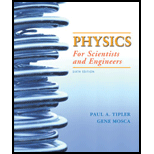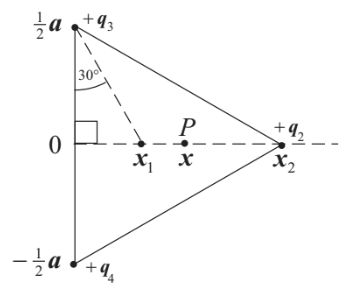
Concept explainers
(a)
The position
(a)
Explanation of Solution
Introduction:
The electric field is the region near the charge where the other object or body will experience the force. The field lines are away from the positive charge and go towards the negative charge.
Draw the representation of the position of the three charges.

Write the expression for the Pythagoras theorem to the above triangle.
Here,
Substitute
Solve the above equation for
Write the expression for the angle.
Substitute
Solve the above equation for
Conclusion:
Thus, the value ofposition
(b)
The electric field.
(b)
Explanation of Solution
Introduction:
The electric field is the region near the charge where the other object or body will experience the force. The field lines are away from the positive charge and go towards the negative charge.
Write the expression for the net electric field at point
Here,
Write the expression for the electric field due to the second charge.
Here,
Substitute
Write the expression for the electric field due to the third charge.
Here,
Substitute
Write the expression for the electric field due to the third charge.
Here,
Substitute
Substitute
Conclusion:
Thus, the value of electric field is
(c)
The electric field is same at
(c)
Explanation of Solution
Formula used:
Write the expression for the electric field at point
Calculation:
Substitute
Substitute
Conclusion:
Thus, the electric field is zero.
Want to see more full solutions like this?
Chapter 21 Solutions
Physics For Scientists And Engineers
- Two particles with charges q1 and q2 are separated by a distance d, and each exerts an electric force on the other with magnitude FE. a. In terms of these quantities, what separation distance would cause the magnitude of the electric force to be halved? b. In terms of these quantities, what separation distance would cause the magnitude of the electric force to be doubled?arrow_forwardCan you arrange the two point charges q1=2.0106C and q2=4.0106C along the x-axis so that E=0 at the origin?arrow_forwardA long copper cylindrical shell of inner radius 2 cm and outer radius 3 cm surrounds concentrically a charged long aluminum rod of radius 1 cm with a charge density of 4 pC/m. All charges on the aluminum rod reside at its surface. The inner surface of the copper shell has exactly charge to that of the aluminum rod while the outer surface of the copper shell has the same charge as the aluminum rod. Find the magnitude and direction of the electric field at points that are at the following distances from the center of the aluminum rod: (a) 0.5 cm, (b) 1.5 cm, (c) 2.5 cm, (d) 3.5 cm, and (e) 7 cm.arrow_forward
- Calculate the electric field due to a uniformly charged rod of length L, aligned with the x-axis with one end at the origin; at a point P on the z-axis.arrow_forwardRecall that in the example of a uniform charged sphere, p0=Q/(43R3). Rewrite the answers in terms of the total charge Q on the sphere.arrow_forwardThree charges, -q, +2q and +2q are placed on the corners of a triangle with all three sides having length a, as shown in the figure. The origin, O, is the middle of the bottom side and the X and Y axes are given by normal unit vectors, i and j, respectively.arrow_forward
- A uniform charge of 16.0 mC is on a thin circular ring lying in an xy plane and centered on the origin.The ring’s radius is 3.00 cm. If point A is at the origin and point B is on the z axis at z = 4.00 cm, what is VB - VA?arrow_forwardTwo point charges, QA = +8 μC and QB = -5 μC, are separated by a horizontal distance r = 10 cm.Compute for the magnitude of the electric force.arrow_forwardWe have four charges, each of which has size given by some integer A, B, C, or D times q, where q=3.75E−07 C. The charges sit in a plane at the corners of a square whose sides have length d=12.5 cm as shown in the diagram below. A charge, of size Eq, is placed at the origin at the center of the square.a) Let A = 4, B = 6, C = 7, D = 8, and E = −2. Consider the charge at the center of the square, Eq. What is the net x-component of the force on this charge? My answer of 1.12 N was wrong, when I accounted for rounding (1.11 and 1.13) it was still wrong b) What is the net force in the y-direction on the center charge? My answer of 1.57 N was wrong, when I accounted for rounding (1.56 and 1.58) it was still wrongarrow_forward
- Two point charges +Q and -Q of mass m are placed on the ends of a massless rod of length L, which is fixed to a table by a pin through its center. If the apparatus is then subjected to a uniform electric field E parallel to the table and perpendicular to the rod, find the net torque on the system of rod plus charges.arrow_forwardThree identical point charges with charge q = 5.0 x 10 ^ -8 C are placed at each vertex of an equilateral triangle. If the side of equilateral triangle is .2m, find the resultant force on the charge at vertex A.arrow_forwardA horizontal wire 3m long has a nonuniform charge per unit length, i.e. = + (0.6x) C/m where x is the distance measured from the left end of the wire. A point P is 1m to the right of the right end of the wire. Find the magnitude and direction of the force experienced by the electron placed at the point P.arrow_forward
 Physics for Scientists and Engineers: Foundations...PhysicsISBN:9781133939146Author:Katz, Debora M.Publisher:Cengage Learning
Physics for Scientists and Engineers: Foundations...PhysicsISBN:9781133939146Author:Katz, Debora M.Publisher:Cengage Learning
 Principles of Physics: A Calculus-Based TextPhysicsISBN:9781133104261Author:Raymond A. Serway, John W. JewettPublisher:Cengage Learning
Principles of Physics: A Calculus-Based TextPhysicsISBN:9781133104261Author:Raymond A. Serway, John W. JewettPublisher:Cengage Learning


